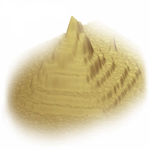|
|
Vol.
27 No. 6
November-December 2005
Nanotechnology: Science and Application
by Mohamed Abdel-Mottaleb
The
International
Conference on NanoTechnology: Science and Application (NanoTech
Insight’05) was held in the beautiful,
historic city of Luxor, Egypt, from 20–25 February 2005.
Over 200 participants—representing leading researchers
from 40 countries—contributed to a very successful conference.
The
scientific content of the meeting was as diverse as it was
high in quality, emphasizing the intrinsic multidisciplinary
nature of nanotechnology. Split into two sessions, the program
featured 22 plenary lectures, 30 keynote lectures, 48 contributed
talks, and 100 posters.
Klaus
Müllen (Max Plank Institute, Mains, Germany) gave the
opening lecture in which he gave an exemplary lesson on “putting
the molecules into molecular electronics” by demonstrating
the self-assembly of polycyclic aromatic hydrocarbons into
columns and ordered monolayers for the formations of supramolecular
wires and two-dimensional crystals. Chemically gated rectifiers
were structured at surfaces by using such systems. Beng Ong
(Xerox Research Labs, Toronto, Canada) provided excellent
proof of the feasibility of this approach to electronics through
Inkjet processing of oligothiophene derivatives to produce
printed field effect transistors with high on/off ratios.
Further examples of molecular electronics and self-assembly
approaches where demonstrated by Concepció Rovira (Consejo
Superior de Investigaciones Cientificas (CSIC), Barcelona,
Spain) and Maria Rampi (Ferrara University, Italy, and Harvard
University, Massachusetts, USA). Avik Ghosh (Purdue University,
Indiana, USA) and Peter Hänggi (Augsberg University,
Germany) elegantly showed how the design and interpretation
of physical experiments now benefit from precision calculation
of the electronic properties of nanostructures.
The 10-nm-size regime is often seen as the realm of these bottom-up molecular approaches; however, top-down CMOS (complementary metal oxide semiconductor) techniques are expected to reach sizes of around this value. Hans Lüth (Research Centre, Jülich, Germany) showed how combinations of the two approaches are certain to be fruitful, and reflected on how new device types will become necessary as the quantum mechanical limit is reached.
Self-assembly
is a powerful paradigm in the preparation of chemical systems
at the nanoscale from the bottom-up approach. In this context
Alan Rowan (Nijmegen, The Netherlands) demonstrated the control
of polymers over nanostructures by threading a catalyst ring
over a polymer chain. Roberto Lazzaroni (Mons-Hainaut, Belgium)
additionally exposed the dramatic effects that block polymer
composition can have on the nanostructures and properties.
Roeland Nolte (Nijmegen, The Netherlands) showed how block
copolymers are even self-assembled into vesicles that can
house enzymes and whose surfaces can be polymerized to create
conducting spheres.
 |
 |
| 11
layers of 4.7 nm—atomic force microscopy image |
6
layers of 10 m—Step Pyramid in Egypt, Netjenkhet
Djoser (2667–2648 BC), The 2nd King of Egypt’s
3rd Dynasty |
| Multilayer
assembly of a thiophene oligomer. From slide presented
by Roberto Lazzaroni. |
|
The versatility of the self-assembly approach was clearly shown by the wealth of structures and properties demonstrated by Dirk Kurth (MPI Colloids and Interfaces, Potsdam, Germany), Jaume Veciana (CSIC, Spain), and Raphaël Lévy (Liverpool, UK).
It has been recognized that natural phenomena can act as a guide to unnatural chemical systems. Paul Hansma (University of California, Santa Barbara, USA) showed how the tools of nanoscience are giving new insight into the way in which nature has developed nanostructured materials with crosslinks, which behave as “sacrificial bonds” and fracture before the backbone of the polymers, which break at a force of over 1000 pN. These safeguards are present in systems as diverse as spider silk, abalone shell, and bone; their elegance is that only these reformable bonds are broken (at forces below 500 pN), thus providing a damage protection mechanism.
“Molecular Surgery” on biological structures was shown by Min-qian Li (Chinese Academy of Sciences, Shanghai, China), who demonstrated the formation of artificial DNA structures via “molecular combing,” and then put the molecules under the knife using an atomic force microscope.
| Perhaps the most remarkable chemical feat . . . was the preparation of a series of triruthenium cluster oligomers . . . |
Perhaps the most remarkable chemical feat exposed at the conference was the preparation of a series of triruthenium cluster oligomers, which in the case of the tetramer displays a 14-step reversible sequence of redox processes involving the transfer of 15 electrons. Tasuku Ito (Tohoku Univer-sity, Japan) showed how judicious choice of ancillary ligands surrounding the complexes can give this effect as well as gradients of potential in dendrimers based on the same module. The systems are surely interesting for molecular electronics.
Paul Ziemann (Ulm, Germany) brought the conference to a fitting climax, showing how metal-loaded block copolymers can be used for the preparation of ordered arrays of both gold and cobalt nanoparticles after removal of the polymer matrix by optimized hydrogen plasma treatment. One of the results presented revealed the remarkable fact that Au55 clusters are Nobler than bulk gold! The outlook for these processes and materials in the preparation of new devices is very promising.
With the high-caliber lectures and posters presented, the conference succeeded in establishing strong collaborations among advanced research groups in the field and the developing world, widening the benefits of nanoscience beyond developed countries, and promoting female scientists. The participants perceived the conference as a scientific, intellectual, and social success. The organizers of the conference would like to issue a warm thank you to all participants for their scientific contributions and for making the event so memorable.
The next NanoTech Insight conference will take place in Cairo, Egypt, 11–17 March 2007.
Dr. Mohamed Abdel-Mottaleb <mohamed.abdel-motaleb @physik.tu-chemnitz.de> is a research associate at the Technical University of Chemnitz, Germany, and was the chairman of NanoTech Insight'05.
Page
last modified 28 October 2005.
Copyright © 2003-2005 International Union of Pure and
Applied Chemistry.
Questions regarding the website, please contact [email protected]
|